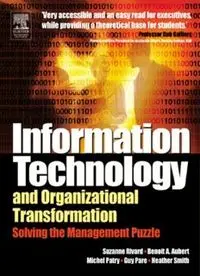
Information Technology and Organizational Transformation: Solving the Management Puzzle PDF
Preview Information Technology and Organizational Transformation: Solving the Management Puzzle
Information Technology and Organizational Transformation Solving the Management Puzzle This Page Intentionally Left Blank Information Technology and Organizational Transformation Solving the Management Puzzle Suzanne Rivard, BenoitA . Aubert, Michel Patry, Guy Paré and HeatherA . Smith AMSTERDAM BOSTON HEIDELBERG LONDON NEW YORK OXFORD PARIS SAN DIEGO SAN FRANCISCO SINGAPORE SYDNEY TOKYO Elsevier Butterworth-Heinemann Linacre House, Jordan Hill, Oxford OX2 8DP 200 Wheeler Road, Burlington, MA 01803 First published 2004 Copyright © 2004, Elsevier Limited. All rights reserved. The right of Suzanne Rivard, Benoit A. Aubert, Michel Patry, Guy Paré and Heather A. Smith to be identified as the authors of this work has been asserted in accordance with the Copyright, Design and Patents Act 1988. All rights reserved. No part of this publication may be reproduced in any material form (including photocopying or storing in any medium by electronic means and whether or not transiently or incidentally to some other use of this publication) without the written permission of the copyright holder except in accordance with the provisions of the Copyright, Designs and Patents Act 1988 or under the terms of a licence issued by the Copyright Licensing Agency Ltd, 90 Tottenham Court Road, London, England W1T 4LP. Applications for the copyright holder’s written permission to reproduce any part of this publication should be addressed to the publisher. Permissions may be sought directly from Elsevier’s Science and Technology Rights Department in Oxford. UK: phone: (⫹44) (0) 1865 843830; fax: (⫹44) (0) 1865 853333; e-mail: Contents Preface xi Part I Management in the twenty-first century organization 1 Chapter 1 The puzzle frames 3 The business frame 5 The customer edge 5 The information edge 7 The change edge 10 The competition edge 12 The business network edge 14 The workforce edge 15 The technology frame 17 The connectivity edge 18 The convergence edge 19 The ubiquity edge 21 The software edge 22 The social frame 23 The demographic edge 23 The diversity edge 24 The international edge 25 The individual edge 26 An outline of the organization of the twenty-first century 26 Size 27 vi Contents Design 28 Function 28 Performance 30 Work 30 Management 32 Conclusion 34 Questions 36 Part II The puzzle pieces 39 Chapter 2 The strategy piece 41 Strategy as positioning 42 Assessing your competition 44 Assessing the threat of entry and substitutes 45 Assessing your business networks 46 Assessing your customers 49 Strategy as capabilities 51 Strategy as governance 53 Strategy: a final word 55 Questions 55 Chapter 3 The structure piece 58 Traditional structural forms 60 A new set of critical success factors 63 Towards boundaryless organizations 69 Conclusion 88 Questions 89 Chapter 4 The information technology piece 93 IT strategy development 94 IT as a support to business strategy 95 IT as a critical driver of business strategy 96 Virtuality vectors affecting strategy 97 IT as a transformational tool 99 Process redesign 100 Improved coordination 100 Improved collaboration 101 Contents vii Improved information use 102 Improved research and learning 103 IT as a competitive weapon 105 Creating virtual value 105 Leveraging customer relationships 106 Customization of products and services 107 Creating new organizational roles and market structures 108 Leveraging intellectual assets 108 IS organization 110 The technology 110 Strategy execution 113 IS skills 113 IS processes 116 IT architecture 117 IS flexibility 119 Conclusion 119 Questions 120 Chapter 5 The leadership piece 123 Personal attributes of a leader 125 Leadership competencies 127 Leadership functions 129 Leadership in the future 132 Questions 133 Part III Putting the puzzle together 137 Chapter 6 Progressive delivers the unexpected – Progressive Insurance 139 Case description 139 A support to business strategy 139 History 141 How Progressive redefined its business 144 How IT was used to reinvent the business 148 Case analysis 152 The pieces of the puzzle at Progressive 152 Putting the puzzle together 160 Questions 163 viii Contents Chapter 7 The organization without an organizational chart – Oticon 165 Case description 165 The company 166 Kolind’s vision 168 The new head office 169 Room to work freely 171 Information and communication 172 Managing problems 174 A complete success 175 Case analysis 176 The pieces of the puzzle at Oticon 176 Putting the puzzle together 187 Questions 190 The paperless office 191 Chapter 8 The virtual value chain – Li & Fung 194 Case description 194 History 195 Business environment 197 Li & Fung in the third millenium 198 Integrated supply chain management 199 Managing human resources 201 An organization with two strong arms 201 On the sell side 202 On the buy side 204 Technology 206 Is Li & Fung successful? 208 Information management 209 Information and success 210 Information technology and flexibility 211 Geography and information 211 Case analysis 212 The pieces of the puzzle at Li & Fung 212 Putting the puzzle together 220 Conclusion 221 Questions 223 Contents ix Part IV The management challenges 227 Chapter 9 People management 231 The changing nature of work 233 The changing nature of workers 235 New management and staff skills 237 Work management skills 237 Individual skills 240 Management skills 242 Relationship management 245 Internal relationships 245 External relationships 246 Conclusion 247 Questions 247 Chapter 10 IT management 250 Aligning IT internally and externally 251 Cultural alignment 252 Strategic alignment 253 Business process alignment 255 IT marketplace alignment 255 Creating a flexible IT organization 256 IT skills management 259 IT architecture 262 Questions 264 Chapter 11 Knowledge management 267 Approaches to knowledge management 269 Developing client-centered knowledge management 270 Improving processes with knowledge 272 Developing communities of practice 273 Developing knowledge management processes 274 Developing knowledge products 275 Best practices for successful knowledge management 276 Organizational and cultural best practices 276 Procedural best practices 278
